Hedge plants are popular landscaping choices for homeowners because they provide a beautiful, low-maintenance hedge. It’s also a great way to add privacy to your property. There are many hedges to choose from, each with different requirements for care. Most hedges are designed to provide visual or privacy protection. Some are also attractive landscape features that can add interest to your yard.
Choose a hedge type that matches your landscaping goals and needs. There are several hedges, each with unique characteristics and care requirements. Decide on the size and shape of the hedge you want. Hedges come in various sizes, from small ornamental plants to large towering trees. You’ll also find dwarf, compact, low-maintenance varieties that can be tucked into tight spaces or used as an informal border around a property.
16 best evergreen flowering shrubs for hedges
Hydrangea
Hydrangea is one of the best low-maintenance hedge plants. They are hardy and will grow in most conditions. Hydrangeas require little care other than regular watering and pruning. Some Hydrangea varieties feature climbing stems that allow them to cover large areas quickly. Because they require relatively little care, hydrangeas make great choices for beginners or those who want a low-maintenance landscape plant. Many Hydrangeas bloom during late spring and early summer, continuing until frost takes hold.
In case you missed it:
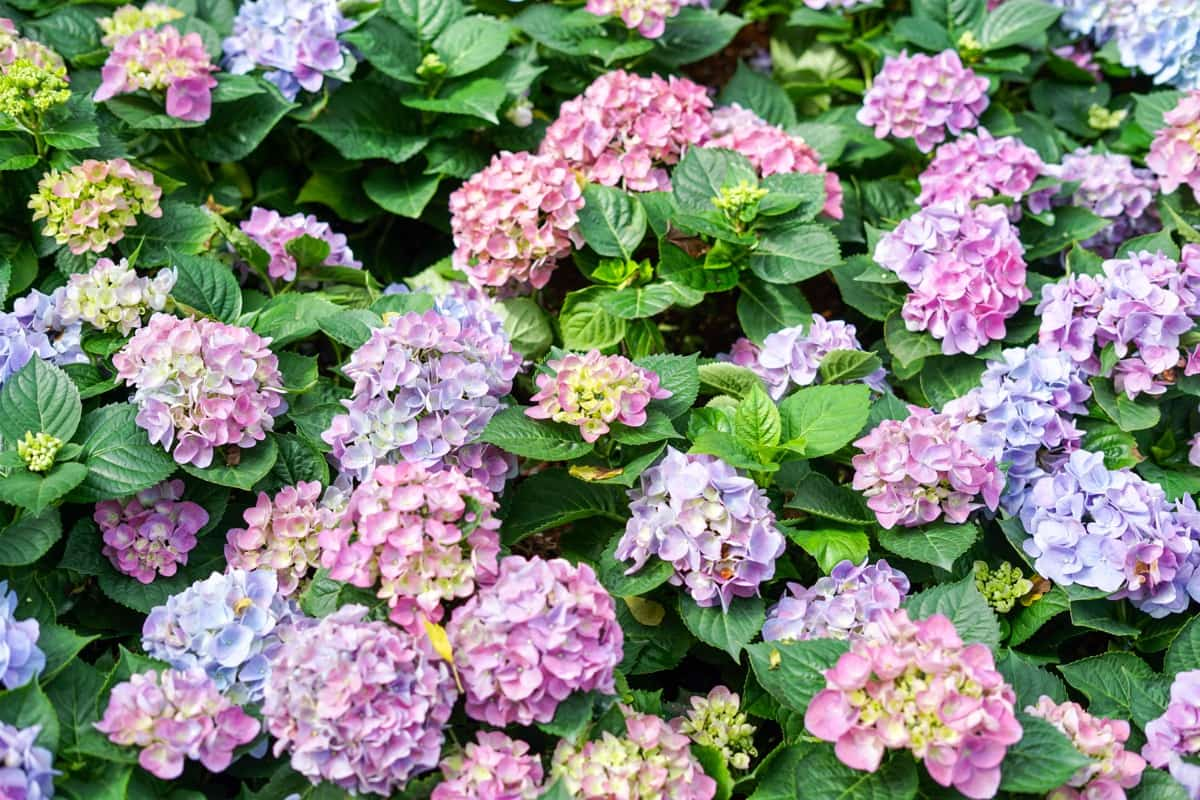
Korean Lilac
Korean Lilacs are a popular hedge plant because they require little care and are relatively easy to grow. These plants can grow tall and wide, with spiny leaves that make them difficult to walk through. They bloom in late spring through early summer, and the flowers are bright pink with a purple center. The blooms can last up to three weeks, and the leaves will turn brown in the fall. Although this plant does not require much care, you should fertilize it every few months to keep it healthy.
Cape Jasmine
Cape Jasmine hedge plants are a favorite among gardeners because they require relatively little maintenance. This evergreen shrub grows 0.5 to 1.5 meters tall and has broad, lance-shaped leaves that are 1 to 2.5 centimeters long and 0.8 to 1 centimeter wide. The flowers are white or pale pink and borne in racemes up to 3 centimeters long.
In case you missed it:

Cape Jasmine requires little maintenance once established; however, you will need to prune it every year in late winter or early spring to keep the branches uniform in size and shape. Additionally, you may want to fertilize it annually with a high-nitrogen product if the blooms are sparse or don’t appear strong.
Japanese Box
Japanese Box hedge plants are low-maintenance and loved for their dense, upright growth. Japanese box hedges can reach heights of 4 to 6 feet and provide privacy or screen property for your home. You will need to water these plants regularly, but other care is minimal. For example, you will need to fertilize them about every two months with a high-nitrogen fertilizer, but there are no other special requirements. This hedge can be used in outdoor and indoor settings, making it a great choice for any garden.
Yew
Yews are a popular hedge plant. They are low maintenance and can grow up to 12 feet tall. Many people find yews visually appealing, and it makes an excellent hedge. Yew is a hardy perennial shrub that can grow tall and wide. It has dark green leaves and clusters of small, fragrant white flowers in the spring. Yew is a popular hedge plant because it’s drought-tolerant and has a long life span.
English Ivy
English Ivy is a popular hedge plant that can care for easily. It grows quickly, forming a dense mat of leaves, and can tolerate various conditions, from low light to full sun. English Ivy can be propagated by root cuttings or stem cuttings taken in the fall. It’s a low-maintenance plant that can be used in various settings, from containers to large borders.
In case you missed it:
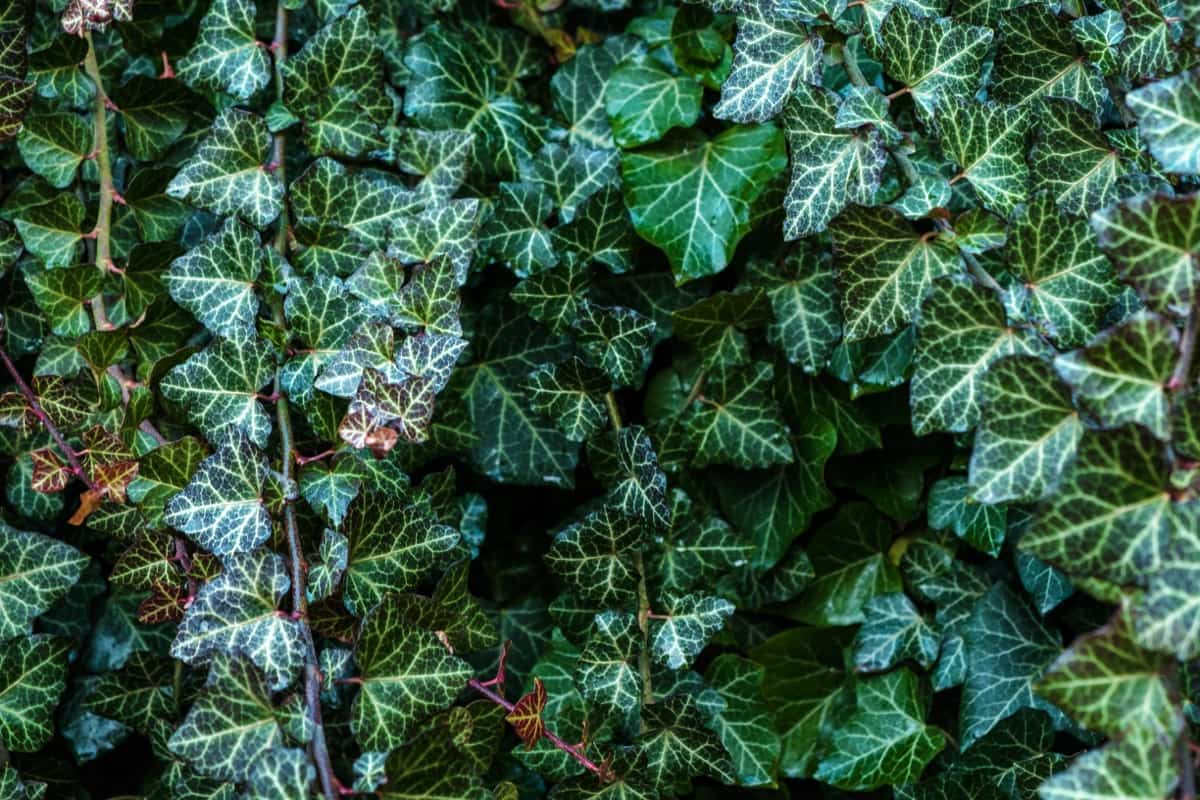
You can propagate it from cuttings taken from established plants. English ivy prefers full sun and well-drained soil but can tolerate partial shade. You should water it regularly, especially in dry climates, and fertilize it monthly with a balanced fertilizer. Prune it back once a year in late winter to early spring to maintain its proportions.
Henna
Henna is a flowering plant that grows in warm climates around the world. A Henna is a plant that grows well in both dry and moist climates. It can be propagated from cuttings taken from the original plants. Henna does not require special care once it is established other than keeping it watered.
If you are growing a Henna plant, there are some basic things you need to care for. First, water it thoroughly every day, especially in the winter when the roots may be dormant. Ensure the soil drains well, and add a little bit of organic matter to help hold moisture. When the weather gets warm and humid, give the plant good watering again.
Pinwheel Flower
Pinwheel Flower is a wonderful low-maintenance hedge plant that will add beauty to your garden. This perennial can grow up to 4 feet tall and has leaves arranged in a pinwheel shape. The flower heads are small but colorful and attract butterflies, bees, and other pollinators to your garden.
When grown in full sun, Pinwheel Flower will get quite large and produce lots of flowers, but it can also be grown in partial shade or indoors if you have a cold climate. To grow this plant, you must water it regularly and fertilize it occasionally. You should also avoid sun exposure, as this plant is prone to sunburn.
Juniper
Juniper is a shrub that can grow up to 6 feet tall and wide. The small, leathery leaves are evergreen and have a Juniper berry at the base. Junipers can be propagated by cuttings or root division in the late winter or early spring. Juniper trees are low-maintenance hedge plants that provide an attractive and long-lasting barrier between your property and the surrounding environment.
In case you missed it:
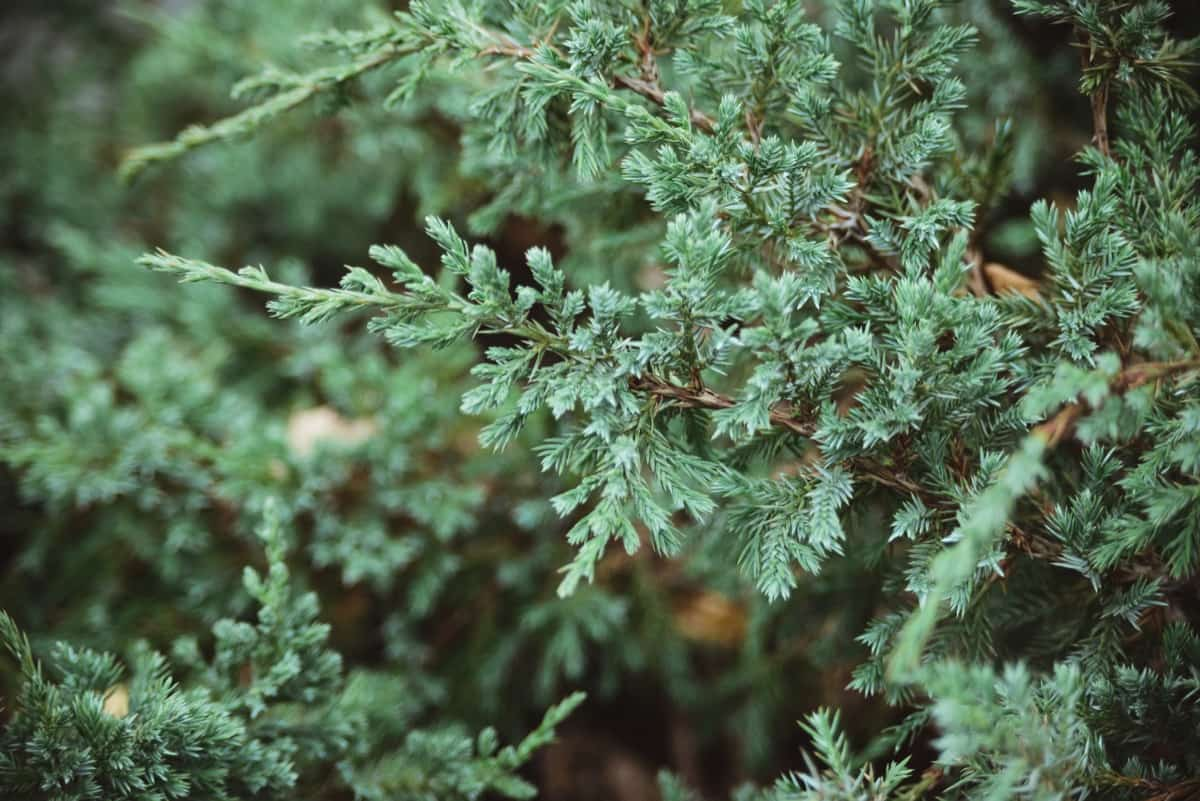
These trees can withstand harsh environments, including wind and rain, making them a good choice for locations that receive a lot of precipitation. The Juniper tree is easy to maintain, requiring little pruning or fertilizing. As long as the Juniper is watered regularly and pest-treated when necessary, it will provide years of service without any need for maintenance other than regular trimming.
Indian Hawthorn
Indian Hawthorn is a deciduous shrub or small tree that can reach 10-15 feet tall and wide. The leaves are ovate to elliptic, 1-3 inches long, and 0.8-1.6 inches wide, with serrated margins. The flowers are white or pink, and the fruit is a dark purple drupe. Indian Hawthorn grows well in various soil types but prefers moist, acidic conditions. It is not tolerant of cold temperatures or heavy rainfall, so it should be planted in full sun or light shade.
The leaves are ovate with sharply pointed tips and are a deep green color. The flowers are small and white with a purple center. Indian Hawthorn grows best in full sun or part shade but will tolerate some shade. It does not require special care other than maintaining an adequate soil moisture level and dividing the plants every few years.
Bougainvillea
Bougainvillea is one of the easiest low-maintenance hedge plants to grow. They require very little water, few fertilizers, and minimal pruning. Bougainvillea can grow up to 12 feet tall and have large flower heads that look like giant umbrellas. They are adaptable to a wide range of climates, making them an excellent choice for areas that experience high or low humidity levels. Bougainvillea does not require much care and is grown in full sun or partial shade.
In case you missed it:
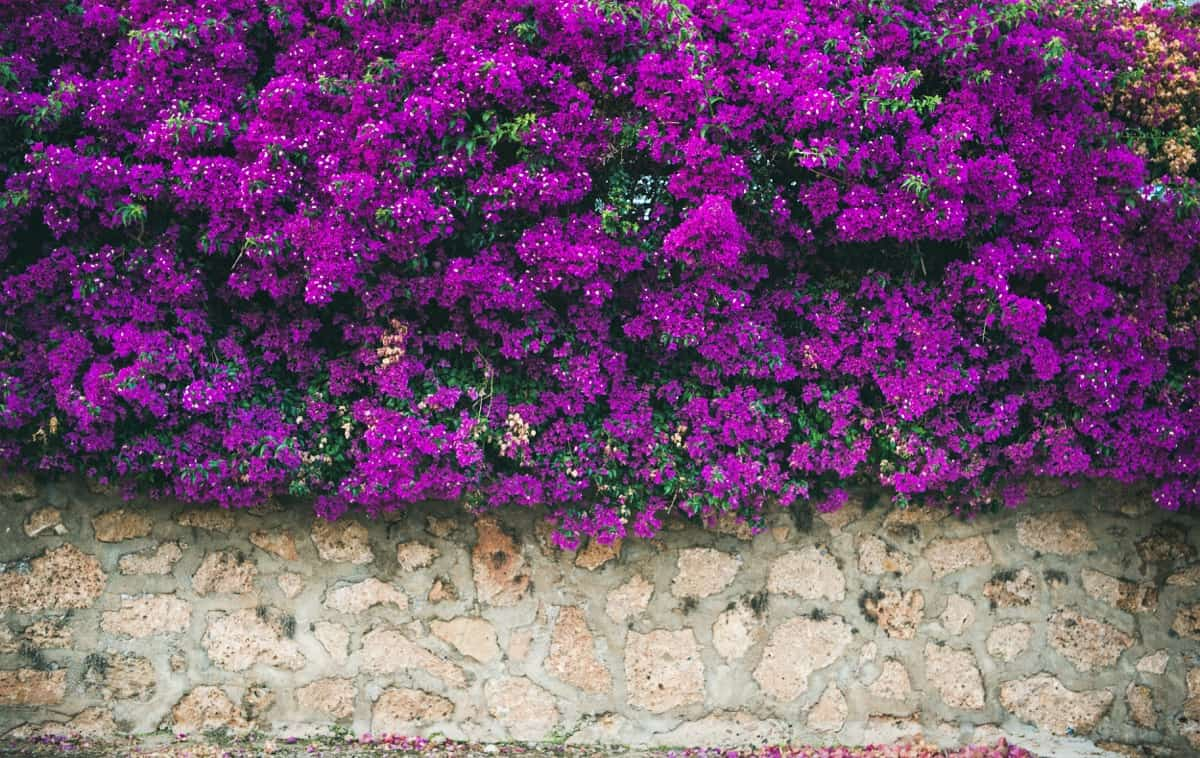
Sweet Osmanthus
Osmanthus is a type of tree often grown as an ornamental due to its sweet-smelling flowers. Osmanthus excels in low maintenance, which means it doesn’t require much water or care. The leaves are oval and have serrated edges. The flowers are fragrant and come in different colors, including yellow, pink, and white.
Osmanthus can be planted outdoors or inside but prefers areas with partial sunlight. Sweet Osmanthus is a popular hedge plant that can be maintained fairly easily. Pruning is usually necessary only once a year, and fertilizing every two weeks will keep the plant healthy. Osmanthus requires little water but prefers well-drained soil, so make sure to give it enough moisture when watering.
Copperleaf plant
A Copperleaf plant is a great option if you’re looking for a low-maintenance hedge plant that will provide years of beauty and privacy. This hardy shrub grows up to 3 feet tall and wide. The plant can be pruned regularly to keep it tidy and manageable, making it a great choice for busy gardeners. The Copperleaf plant is a low-maintenance hedge plant that is perfect for small gardens. This evergreen shrub has heart-shaped leaves that are copper in color. The Copperleaf plant is drought resistant and will thrive in areas that receive partial sunlight or shade.
Coleus
If you’re looking for low-maintenance plants to add to your garden, Coleus could be a good option. This flowering plant is easy to grow and doesn’t require much care. You must water regularly and fertilize it once a month. Coleus can be used in several different ways in your garden. You can add them to borders or mix in with other flowers. They are also drought tolerant, so they will do well even if your soil is dry.
Hibiscus
Hibiscus may be a good option if you’re looking for a low-maintenance hedge plant. Hibiscus flowers are typically large and are often used in floral arrangements or as part of decorative gardens. They require very little maintenance and can be grown easily in most climates. Hibiscus needs plenty of water to stay healthy and grow.
In case you missed it:
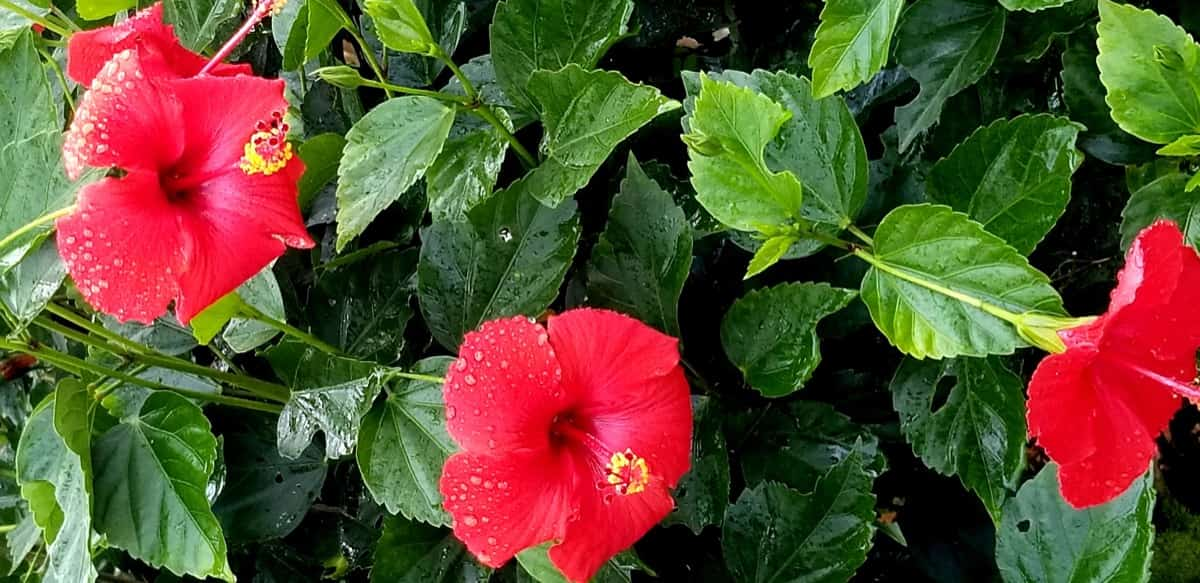
Hibiscus don’t require heavy fertilization, but occasional feeding with a weak fertilizer will help keep them lush and green. Hibiscus will grow branches naturally, but you may want to prune them back occasionally to maintain a uniform shape. Use mulch or gravel layers throughout the season to protect your Hibiscus plants from hard rains.
Golden Dewdrop
Golden Dewdrop is a flowering shrub with gorgeous golden flowers that can be found growing in warmer climates. It grows to four feet tall and has an attractive, spreading habit. The leaves are green, and the flowers are yellow and orange. Golden Dewdrop is a great choice for hedges because it spreads slowly, has attractive flowers, and is resistant to pests and diseases.
Conclusion
A hedge plant is a beautiful addition to any yard and a great way to keep pests at bay. They provide shade and privacy, and hedges add a touch of nature to your space. If you’re looking to add an evergreen or flowering shrub to your hedge collection, check out these best-ever plants for hedges. Choosing the right shrub for your area and garden can create a beautiful hedge to protect your plants from pests and other dangers.
- Flower Garden Designs and Layouts for Beginners
- Planting and Spacing Techniques in Papaya: A Beginner’s Guide
- Growing Gold: Essential Techniques for Planting Pineapples
- How to Make Kalanchoe Plant Bushy: Home Remedies and Solutions
- 11 Reasons Why Your Gardenia is Not Blooming: Home Remedies and Solutions
- Eco Elegance: The Guide to Designing a Drought-Tolerant Landscape
- Gardening on a Slope: Strategies for Hillside Landscaping
- Nourish and Flourish: Top Organic Mulches for Thriving House Plants
- Everything You Want to Know about Indian Mogra Flower: Discover Uses and Growing
- Green Thumb Success: Expert Tips for Cultivating Greenhouse Pumpkins All Year Round
- Maximize Growth & Flavor: The Ultimate Guide to Companion Planting in Herb Gardens
- How to Control Rhododendron Problems Naturally: Home Remedies and Organic Ways to Fix Them
- Natural Magic: The Remarkable Benefits of Cinnamon for Plants
- Best Steps to Revive Dying Tulip with Natural and Organic Treatment
- 10 Reasons Why Your Angel Trumpet is Not Blooming: Remedies and Treatment
- How to Fix Periwinkle Leaf and Flower-Related Problems: Natural Remedies and Solutions
- How to Fix Zinnias Leaf and Flower Problems: Discover Natural and Home Remedies
- Organic Steps to Induce Lemon Tree Flowers: A Comprehensive Guide
- Bloom Booster: Crafting the Perfect Homemade Bougainvillea Fertilizer
- Optimizing Growth: A Guide to Applying NPK Fertilizer for Potted Plants
- 10 Best Homemade Fertilizers for Rubber Plant: DIY Recipes and Application Method
- How to Boost Female Pumpkin Flowers: Effective Steps for More Flowers and High Yields
- Transform Your Indoor Garden: Top Benefits of Pink Salt for Houseplants
- 10 Best Homemade Fertilizers for Peacock Plants (Calathea): Easy DIY Guide
- Unlock Blooms: 9 Reasons Why Your Potted Chrysanthemum is Not Blooming
- 8 Reasons Why Your Potted Hibiscus is Not Blooming: Fix it with Simple Solutions
- Unlock Blooms: 9 Key Reasons Your Potted Frangipani Won’t Flower
- 10 Reasons Why Is My Ice Plant Not Blooming: Remedies and Treatment
- 10 Reasons Why My Potted Hydrangea Not Blooming: Treatment and Remedies
- 10 Reasons Why is My Wisteria Not Blooming: Remedies and Treatment
- 10 Reasons Why is My Goldfish Plant Not Blooming: Remedies and Treatment
- Maximize Your Space: Ultimate Guide to Balcony Gardening with Grow Bags
- 10 Reasons Why Your Iris is Not Blooming: Remedies and Treatment
- 10 Reasons Why Your Anthurium Plant is Not Blooming: Treatment and Remedies
- 10 Reasons Why Your Aquaponic Plants Are Not Flowering: Remedies and Treatment
- 10 Reasons Why Your Agapanthus is Not Flowering: Remedies and Treatment